Elsie Inglis
| Elsie Maud Inglis | |
|---|---|
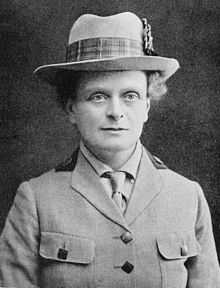 Elsie Inglis | |
| Born |
16 August 1864 Naini Tal, India |
| Died |
26 November 1917 (aged 53) Newcastle upon Tyne, UK |
| Nationality | British |
| Other names | The Lady with the Torch |
| Alma mater | University of Edinburgh |
| Occupation | Doctor |
| Known for | Suffragist; World War I doctor |
Elsie Inglis (16 August 1864 – 26 November 1917) was an innovative Scottish doctor and suffragist.
Education
She was born in the hill station town of Naini Tal, India, to John Forbes David Inglis who worked in the Indian civil service as Chief Commissioner of Oudh. She had the good fortune to have relatively enlightened parents for the time who considered the education of a daughter as important as that of the son. After a private education her decision to study medicine was delayed by her mother's death in 1885, when she felt obliged to stay in Edinburgh with her father. However, the next year the Edinburgh School of Medicine for Women was opened by Dr Sophia Jex-Blake and Inglis started her studies there. After founding her own breakaway medical college as a reaction to Jex-Blake's uncompromising ways, she completed her training under Sir William Macewen at the Glasgow Royal Infirmary.
She qualified as a licentiate of both the Royal College of Physicians and Surgeons, Edinburgh, and the Faculty of Physicians and Surgeons of Glasgow in 1892. She was appalled by the general standard of care and lack of specialisation in the needs of female patients, but was able to obtain a post at Elizabeth Garrett Anderson's pioneering New Hospital for Women in London, and then at the Rotunda in Dublin, a leading maternity hospital.
Medical practice
She returned to Edinburgh in 1894 where she set up a medical practice with Jessie MacLaren MacGregor, who had been a fellow student, and also opened a maternity hospital (The Hospice) for poor women alongside a midwifery resource centre, which was a forerunner of the Elsie Inglis Memorial Hospital. The Hospice was within 219 High Street, on the Royal Mile, close to Cockburn Street[1]
A philanthropist, she often waived the fees owed to her and would pay for her patients to recuperate by the sea-side. She was a consultant at Bruntsfield Hospital for women and children, and despite a disagreement between Inglis and the hospital management, the Hospice joined forces with them in 1910.
Her dissatisfaction with the standard of medical care available to women led to her becoming politically active and playing an important role in the early years of the Scottish Federation of Women's Suffrage Societies, acting as honorary secretary from 1906 to 1914.[2]
World War I
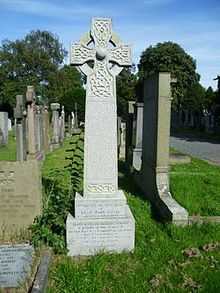
Despite her already notable achievements it was her efforts during the First World War that brought her fame. She was instrumental in setting up the Scottish Women's Hospitals for Foreign Service Committee, an organisation funded by the women's suffrage movement with the express aim of providing all female staffed relief hospitals for the Allied war effort. The organisation was active in sending teams to France, Serbia and Russia.
When Elsie Inglis approached the Royal Army Medical Corps to offer them a ready-made Medical Unit staffed by qualified women, the War Office told her "My good lady, go home and sit still". It was, instead, the French government that took up her offer and established her unit in Serbia. [3]
Elsie Inglis, herself, went with the teams sent to Serbia where her presence and work in improving hygiene reduced typhus and other epidemics that had been raging there. In 1915 she was captured and repatriated but upon reaching home she began organising funds for a Scottish Women's Hospital team in Russia. She headed the team when it left for Odessa, Russia in 1916 but lasted only a year before she was forced to return to the United Kingdom, suffering from cancer.
Honours
In April 1916, Elsie Inglis became the first woman to be awarded the Order of the White Eagle (V class) by the Crown Prince of Serbia at a ceremony in London.[4][5][6] She had previously been awarded the Order of Saint Sava (III class).[4]
Death and burial
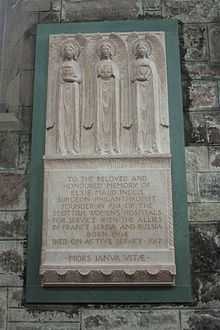
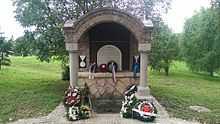
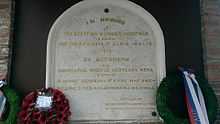
She died on 26 November 1917, the day after she arrived back in the UK, at the Station Hotel Newcastle upon Tyne. Her funeral service at St Giles Cathedral in Edinburgh on 29 November was "the occasion of an impressive public tribute", according to The Scotsman. Winston Churchill said of Inglis and her nurses "they will shine in history".
A separate memorial service was held on 30 November at St Margarets Church in Westminster, London.
She is buried in the north section of Dean Cemetery, on a corner north of the central path.
Memorials
In 1922 a large tablet to her memory (sculpted by Pilkington Jackson) was erected in the north aisle of St Giles Cathedral, in Edinburgh.
A memorial fountain was erected in her memory in Mladenovac, Serbia, commemorating her work for the country.
A plaque marking her pre-war surgery from 1898 to 1914 was erected at 8 Walker Street, Edinburgh.
In March 2015, the British Residence in Belgrade was renamed 'Elsie Inglis House' in recognition of her work in the country. [7]
Elsie Inglis was commemorated on a new series of banknotes issued by the Clydesdale Bank in 2009; her image appeared on the new issue of £50 notes.[8][9]
Her main physical memorial was the building of the Elsie Inglis Memorial Hospital in 1925 (see separate article). This primarily ran as a maternity hospital and thereby had a female-only patient base. Many Edinburgh children were born there during the 20th century. It was closed by the National Health Service in 1988 and sold off. Part is now an old folks home, part is private housing and parts are demolished. It is no longer recognisable as a hospital. A small plaque to Elsie Inglis exists near the south-west corner at the entrance to Holyrood Park.[1]
Archives
The archives of the Scottish Women's Hospitals for Foreign Service are held at The Women's Library at the Library of the London School of Economics, ref 2SWH
References
- ↑ 1.0 1.1 http://historycompany.co.uk/2014/02/06/the-legacy-of-elsie-inglis-edinburghs-shame/
- ↑ Lovejoy, Esther Pohl (1957). Women Doctors of the World. New York: Macmillan. p. 288.
- ↑ Beauman, Nicola (2008). A very great profession : the woman's novel 1914-1939 (rev.ed. ed.). London: Persephone Books. p. 23. ISBN 9781903155684.
- ↑ 4.0 4.1 "Serbian White Eagle: Scotswoman as the first woman recipient", Aberdeen Journal, 15 April 1916
- ↑ "Calls to restore 'forgotten' Elsie Inglis grave", Edinburgh Evening News, 8 November 2013, retrieved 11 February 2014
- ↑ Medals and papers of Dr Elsie Inglis, Royal College of Surgeons of Edinburgh Library & Archive, 2009, retrieved 11 February 2014
- ↑ "Serbia honours life of war doctor Elsie Inglis". Edinburgh Evening News. 17 March 2015. Retrieved 17 March 2015.
- ↑ "Banknote designs mark Homecoming". BBC News. 14 January 2008. Retrieved 20 January 2009.
- ↑ The Scotsman: "Bank proves Elsie Inglis was woman of (£50) note".
Sources
- Oxford Dictionary of National Biography
- Short biography
- Bruntsfield Hospital and Elsie Inglis Memorial Maternity Hospital (Lothian Health Services Archive)
- The Scotsman archives
Further reading
| Wikimedia Commons has media related to Elsie Inglis. |
- Elsie Inglis: The Woman with the Torch at Project Gutenberg
- Leneman, Leah (1998). Elsie Inglis: Founder of battlefront hospitals run entirely by women. NMS Publishing Limited. ISBN 1-901663-09-4
|